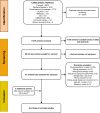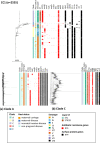Molecular epidemiology of Streptococcus agalactiae in non-pregnant populations: a systematic review
- PMID: 38019122
- PMCID: PMC10711312
- DOI: 10.1099/mgen.0.001140
Molecular epidemiology of Streptococcus agalactiae in non-pregnant populations: a systematic review
Abstract
Streptococcus agalactiae (group B Streptococcus, GBS) has recently emerged as an important pathogen among adults. However, it is overlooked in this population, with all global efforts being directed towards its containment among pregnant women and neonates. This systematic review assessed the molecular epidemiology and compared how the lineages circulating among non-pregnant populations relate to those of pregnant and neonatal populations worldwide. A systematic search was performed across nine databases from 1 January 2000 up to and including 20 September 2021, with no language restrictions. The Joanna Briggs Institute (JBI) Prevalence Critical Appraisal Tool (PCAT) was used to assess the quality of included studies. The global population structure of GBS from the non-pregnant population was analysed using in silico typing and phylogenetic reconstruction tools. Twenty-four articles out of 13 509 retrieved across 9 databases were eligible. Most studies were conducted in the World Health Organization European region (12/24, 50 %), followed by the Western Pacific region (6/24, 25 %) and the Americas region (6/24, 25 %). Serotype V (23%, 2310/10240) and clonal complex (CC) 1 (29 %, 2157/7470) were the most frequent serotype and CC, respectively. The pilus island PI1 : PI2A combination (29 %, 3931/13751) was the most prevalent surface protein gene, while the tetracycline resistance tetM (55 %, 5892/10624) was the leading antibiotic resistance gene. This study highlights that, given the common serotype distribution identified among non-pregnant populations (V, III, Ia, Ib, II and IV), vaccines including these six serotypes will provide broad coverage. The study indicates advanced molecular epidemiology studies, especially in resource-constrained settings for evidence-based decisions. Finally, the study shows that considering all at-risk populations in an inclusive approach is essential to ensure the sustainable containment of GBS.
Keywords: One Health; Streptococcus agalactiae; antibiotic resistance; molecular epidemiology; non-pregnant populations; virulence.
Conflict of interest statement
The authors declare that there are no conflicts of interest.
Figures






References
-
- World Health Organization (WHO) WHO Preferred Product Characteristics for Group B Streptococcus Vaccines. Geneva: World Health Organization; 2017.
Publication types
MeSH terms
Substances
LinkOut - more resources
Full Text Sources
Medical
Research Materials

